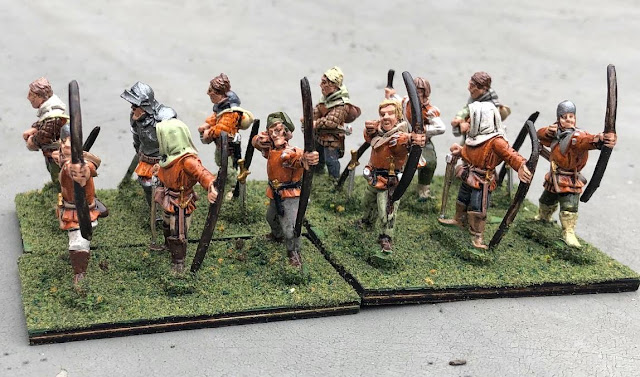 These archers join their pole-armed fellows in the cause of John de Vere, Earl of Oxford... and whomever he might be supporting this season!
These archers join their pole-armed fellows in the cause of John de Vere, Earl of Oxford... and whomever he might be supporting this season!
These less well equipped fellows are intended to reflect more hastily armed Levy troops, as opposed to formal "Retinue" of a major Lord.
Archery was important during the Wars of the Roses, but not the battle winning force it (seemed) to be during the Hundred Years War.
That's probably due to combination of both sides having men so armed, and some degree of exaggeration of the effectiveness of Longbows stemming from the famous battles of Crecy, Potiers, and Agincourt... three major victories over a century of conflict.
They once again are distinguished by the "Tawney" of Oxford's livery.
"And the multitude of their arrows darkened the sky..." or not; ammunition could be limited. Accounts of battles in this era include the archers foraging for arrows to be re-used.





I like the rabble look to your levy archers. Which Ceramcoat are you using for tawny?
ReplyDeleteThanks, Jon. That's "terra Cotta", one of my favorite colors from the,... which of course means they probably don't make it any longer!
DeleteThat is the color I use for tawny too!
DeleteIt is just about a perfect orange-brown color. Also great for untanned leather.
DeleteYou are really motoring your way through these, Lovely work and the tawny colour looks great. The faces on these sculpts are quite expressive which really adds to the character.
ReplyDeleteThank you Lawrence. yes, The Face is strong with them! :-)
DeleteVery nice work again Peter and without any disrespect to the Perrys, it's nice to see another range of WotR figures being used! The Old Glory figures look very good indeed. There is a lot if revisionist theory being written about the English longbow, but I think it was still a pretty fearsome weapon, particularly by the standards of the age ( and later) I suspect an equal number of archers, firing off ten or fifteen yard long arrows per minute, would have had a pretty devastating effect on the musket armed infantry of two or three centuries later .....
ReplyDeleteAs you know, there have been essays about the longbow versus the musket, and I think it is safe to say that against an unarmored target, the longbow is superior. The difference is that it takes but a short time to train a musketeer, versus a lifetime for an archer, and the musket shoots the same (more or less) no matter how tired the wielder is!
DeleteNice figures. I agree on the longbows Peter. Also it must be much easier when there is no effective missile opposition.
ReplyDeleteYes, I think the lack of a corresponding weapon was a key difference in the HYW vs. WotR.
DeleteGood looking levy archers, war of the Roses battles were often arrow storm followed by dismounted men at arms melee so now cavalry to take out which is where the damage tended to happen against the French, there were other victories apart from the famous three, so much so that the French tended to avoid pitch battles.
ReplyDeleteBest Iain
There were reasons for laws in England requiring archery practice back then!
DeleteWonderful painting Peter. I love Terracotta as well so there’s another reason it will be discontinued or worse, altered in shade and renamed! Really impressed at the rate of knots you’re moving at on this great period.
ReplyDeleteThank you, Carlo; there is a deadline involved here; they all have to be completed by mid July at the latest!
DeleteLooks like you are having fun with these units. They look very thematic with your color choices. You are having a very productive spring!
ReplyDeleteThanks, Joe. I am enjoying painting these rather more than expected, and without too much stretching they can see use for other 15th century century conflicts such as the Swiss-Burgundian Wars and the Hussite Wars, and even the later HYW (Agincourt).
Delete